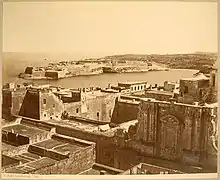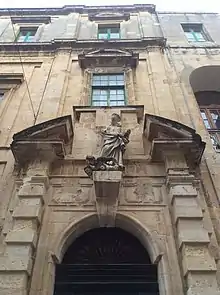Old University Building, Valletta
The Old University Building (Maltese: L-Università l-Qadima or L-Università l-Antika), also known as the Valletta Campus, is the original campus of the University of Malta, located adjacent to the Church of the Jesuits in Valletta, Malta. Construction of the building began in 1595, and it originally housed a Jesuit college known as the Collegium Melitense Societatis Jesu.[2] The building had to be repaired after being damaged in an explosion in 1634 and an earthquake in 1693.
| Old University Building | |
|---|---|
L-Università l-Qadima | |
 Part of the façade of the Old University Building in Merchants Street | |

| |
| Former names | Collegium Melitense Societatis Jesu |
| Alternative names | Valletta Campus |
| General information | |
| Status | Intact |
| Type | Educational building |
| Architectural style | Renaissance |
| Location | Valletta, Malta |
| Coordinates | 35°53′54″N 14°30′56″E |
| Construction started | 4 September 1595 |
| Completed | 1602 |
| Opened | 1597 |
| Owner | University of Malta (since mid-2020)[1] |
| Technical details | |
| Material | Limestone |
| Floor count | 3 |
| Design and construction | |
| Architect | Giuseppe Valeriano Francesco Buonamici |
The University of Malta was established in 1769 after the Jesuits were expelled, and it continued to use the same building.[3] Although the University moved to a much larger campus at Tal-Qroqq in Msida in the 1960s, the Old University Building still houses a number of University departments and it is used for some lectures and conferences.
History

Background and construction
The precursor to the University of Malta was the Collegium Melitense Societatis Jesu, a Jesuit college which was set up on 12 November 1592.[2][4][5] This was originally located in an old house in Valletta,[6] but a new complex to house the college and a Jesuit church had already been commissioned by Bishop Tommaso Gargallo.[7][8] The building was designed by Giuseppe Valeriano[9] (later alterations were carried out by other architects, possibly including Vincenzo Casanova).[10]
Construction of the present building began on 4 September 1595 when the foundation stone was laid down by Grand Master Martin Garzez.[5][9] Construction proceeded quickly, and the college moved into the building in 1597,[6] while construction was completed in 1602.[9] The church was completed in 1609.[6]
Use and events

On 12 September 1634, both the college and the adjacent church were severely damaged when a gunpowder factory exploded.[11][12] The buildings were repaired, and the church had its façade completely rebuilt.[6] The new design was entrusted to Francesco Buonamici.[13][14] Further damage occurred during the 1693 Sicily earthquake. In 1695, a sundial with a Latin inscription was installed on the rear of the building.[6] In the early 18th century, part of the building was converted into a permanent exhibition by housing artifacts from Ciantar’s antiquities collection which came from his former residence in Marsa. This brought the attention of several historians at the time, raising the interest of antiquity in Malta at the time. However, soon after the expulsion of the Jesuits, the collection went sparse among those interested to acquire them with minimal concern over the preservation of the artifacts.[15]

The Jesuits were expelled from Malta in 1768, and the building became property of the Treasury of the Order of St. John. However, studies continued and the professors retained their posts.[6] The Pope confirmed the founding of the university of Malta on 20 October 1769.[16] The University of Malta officially came to existence on 22 November 1769, when Grand Master Manuel Pinto da Fonseca signed a decree constituting a Pubblica Università di Studi Generali.[17] The University was briefly suspended during the magistracy of Francisco Ximenes de Texada in the 1770s, but it was reconstituted by his successor Emmanuel de Rohan-Polduc in 1779.[4]
The University was replaced by the École Centrale during the French occupation of Malta from 1798 to 1800, but was once again reopened by Sir Alexander Ball during the British Protectorate of Malta. Parts of the building were rented out as commercial rooms in the early 19th century, amongst which was the first bank of Malta (the Anglo-Maltese Bank) found on 20 June 1809.[18] The commercial rooms were reconstructed in 1810. In May 1824, a secondary entrance decorated with the British coat of arms was opened in the rear of the building. During World War II, the building housed an Air Raid Precautions Centre. At times, it also housed the Anglo-Maltese Library and the Lyceum.[6][19]
Over time, the campus became too small to house the entire university. Evans Laboratories (now known as Evans Building), a building near the Sacra Infermeria in Valletta, was inaugurated in 1959 in order to house the Faculty of Science. In 1968, the Medical School moved to a building near St. Luke's Hospital in Gwardamanġa. The University opened a much larger campus at Tal-Qroqq in Msida in the late 1960s, and most Faculties moved there.[4] The University only retained the first floor of the Valletta building, and moved out of the second floor in 1978. However, the University refurbished and reopened the second floor once again in 2011.[20]

The Old University Building is now one of the three campuses of the University of Malta, the others being the Msida campus and the Gozo Campus in Xewkija.[21] At one point, the head offices of Heritage Malta were located within the building.[6] Today, the Valletta Campus houses the International Collaborative Programmes,[22] the Research Innovation & Development Trust[23] and the Conferences and Events Unit.[24] It is also used for international conferences and seminars, along with a number of short courses and summer schools.[21]
Architecture
.jpg.webp)
The Old University Building is located within a city block bordered by Merchants, St. Christopher, St. Paul and Archbishop Streets, and it is located adjacent to the Jesuit church, which was constructed at the same time as the college.[6] The building is three stories high.[7] Its plan is typical of Renaissance-era public buildings, consisting of rooms built around a central courtyard.[6] These include lecture halls, classrooms and cells for the Jesuit priests, all connected to corridors.[7] Today, some of the cells are used as offices.[6] The building also contains a number of boardrooms, lecture rooms, meeting rooms, an auditorium and an Aula Magna.[29]
The rear entrance which was opened in 1824 is an example of neoclassical architecture, and it consists of an archway with two Doric columns supporting a lintel, above which is a representation of the Royal coat of arms of the United Kingdom. The lintel bears a Greek inscription meaning "learning is the gateway to distinction".[6] This gate is commonly attributed to Giorgio Pullicino, who was the professor of architecture at the University at the time. It has also been attributed to Colonel George Whitmore of the Royal Engineers, but this is unlikely. The design seems to have been inspired from the Hôtel d'Hallwyll by Claude Nicolas Ledoux, which was built in Paris in 1766–70.[30]
References
- https://www.um.edu.mt/newspoint/jc/resolution-towards-properties-transfer
- Greene, Molly (2010). "At the Tribunal". Catholic Pirates and Greek Merchants: A Maritime History of the Early Modern Mediterranean. Princeton University Press. pp. 167–200. doi:10.2307/j.ctv4w3sv3.12. ISBN 978-0-691-14197-8. JSTOR j.ctv4w3sv3.12.
- "University founded on Christian principles". Timesofmalta.com. 1940-08-22. Retrieved 2019-11-22.
- "History of the University". University of Malta. Archived from the original on 6 January 2018.
- De Lucca, Denis (2012). "The Case of Giacomo Masò". Jesuits and Fortifications: The Contribution of the Jesuits to Military Architecture in the Baroque Age. pp. 240–242. ISBN 9789004216518.
- "History of the University of Malta Valletta Campus". University of Malta. 20 January 2015. Archived from the original on 9 January 2018.
- "Old University" (PDF). National Inventory of the Cultural Property of the Maltese Islands. 28 December 2012. Archived from the original (PDF) on 11 January 2018.
- "Scientia" (PDF). melitensiawth.com. 2007. Retrieved 2020-02-20.
- Fiorini, Stanley. "The Collegium Melitense and the Universitas Studiorum to 1798" (PDF). Yesterday's Schools: Readings in Maltese Educational History: 35. Archived from the original (PDF) on 11 August 2017.
- Montanaro, Eugene F. (1992). "The Building of a New Church dedicated to Saint Julian 1682". Melita Historica. 11 (1): 35–58.
- De Lucca, Denis (2006). Francesco Buonamici - Painter, Architect and Military Engineer in Seventeenth Century Malta and Italy. International Institute for Baroque Studies. p. 38. ISBN 99932-0-435-8.
- Azzopardi, Joe (December 2016). "The Architectural Development of the Jesuit Church in Valletta" (PDF). Vigilo (48): 35–39.
- Sciberras, Keith (December 2007). "An Architect in Context - Francesco Buonamici" (PDF). Baroque Routes (7): 14, 15.
- Thake, Conrad (Summer 1995). "Scenographic Baroque Staircases". Treasures of Malta. Fondazzjoni Patrimonju Malti. 1 (3).
- Mercieca, Simon (2014). "The Proserpina Temple and the History of its Chrestion Inscription" (PDF). Treasures of Malta, 61. 21 (1): 32–39. Archived from the original (PDF) on 29 June 2019.
- "Tobba Maltin matul iż-Żminijiet" (PDF). www.um.edu.mt. 1989. Retrieved 2020-05-29.
- Berry, John Anthony; Micallef, Martin, eds. (April 1948). "Editorial: Royal University Foundation Day" (PDF). Melita Theologica: A Review of the Royal University Students' Theological Association. 1 (3): 4. ISSN 1012-9588.
- "Grima, J. F. (2019, June 16). Malta's first bank. The Sunday Times of Malta, pp. 56-57" (PDF).
- Bianco, Lino (2009). "Valletta: A city in history" (PDF). Melita Theologica. University of Malta: Department of Architecture and Urban Design - Faculty for the Built Environment. 60 (2): 3–20. ISSN 1012-9588. OCLC 1587122. Archived from the original (PDF) on 19 March 2018.
- "University retakes possession of all of its old Valletta building". Times of Malta. 12 May 2011. Archived from the original on 26 January 2018.
- "The University". University of Malta. Archived from the original on 6 January 2018.
- "International Collaborative Programmes". University of Malta. Archived from the original on 6 January 2018.
- "Contact". Research, Innovation & Development Trust. Archived from the original on 25 July 2017.
- "Conferences and Events Unit". University of Malta. Archived from the original on 6 January 2018.
- "Two Valletta buildings get a much needed facelift". Public Service. 10 November 2016. Archived from the original on 26 January 2018.
- Varis, Leeni (30 May 2016). "Jesuits church, old university facade getting much-needed restoration". Times of Malta. Archived from the original on 26 January 2018.
- "17th century Jesuits' Church in high spirits after major restoration". Times of Malta. 19 January 2018. Archived from the original on 19 January 2018.
- "External restoration works on the old University". TVM. 5 April 2019. Archived from the original on 6 April 2019.
- "Valletta Venues". University of Malta. Archived from the original on 6 January 2018.
- Ellul, Michael (1982). "Art and architecture in Malta in the early nineteenth century" (PDF). Proceedings of History Week: 15. Archived from the original (PDF) on 22 April 2016.
External links
![]() Media related to University of Malta Valletta Campus at Wikimedia Commons
Media related to University of Malta Valletta Campus at Wikimedia Commons
